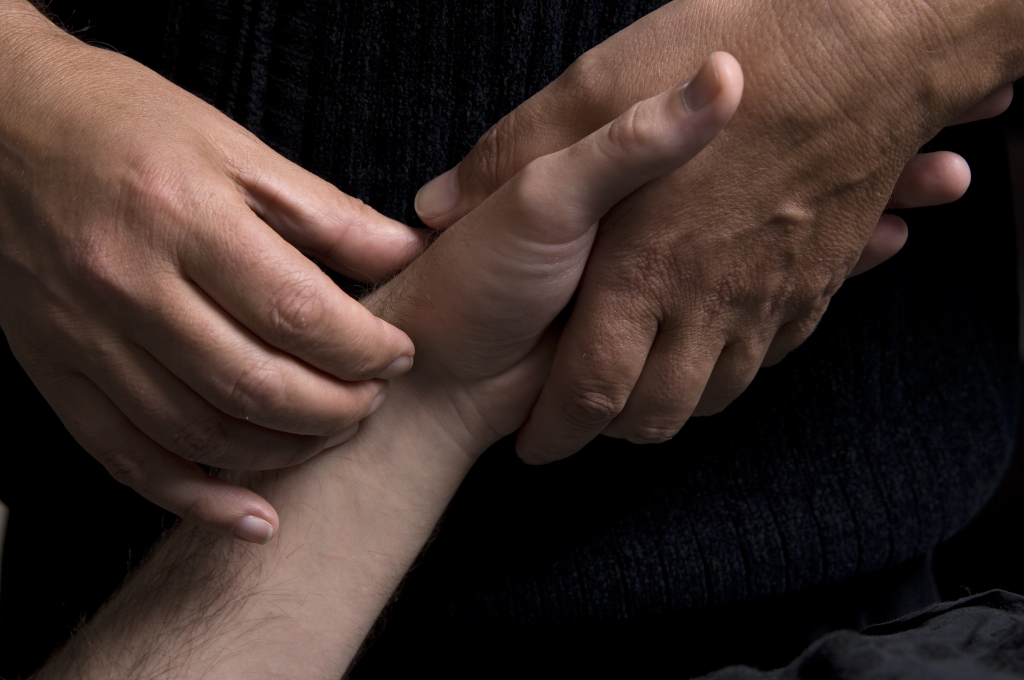Subscribe to the Newsletter
If you are interested in understanding how Traditional Chinese Medicine can improve your life sign up to my newsletter for the latest updates.

Pulse diagnosis has been made into an art form by the Chinese, whereas few Western-trained doctors know how to evaluate your pulse, except by counting it.
Learning to recognise the different qualities takes effort and experience, but for acupuncturists it’s worth it!
What does Pulse Diagnosis mean? The (Western-medicine) doctor or nurse who takes your pulse the usual way just counts your radial pulse rate.
The ‘Normal’ rate is 72 per minute. Often they don’t wait a minute while doing it: they count it for 15 seconds, and multiply by 4 to get the rate for a whole minute.
Someone trained in Chinese Pulse Diagnosis would probably take much longer than 15 seconds.
Why? Surely a pulse-rate is a pulse-rate?
Here you’ve exposed a weakness in Western medicine, which has trapped itself into judging things purely on the results of data measured by scientific instruments.
Although we need those careful instrumental tests, they tend to ignore the wealth of information that is qualitative rather than quantitative. This qualitative information comes via our senses: via our senses of touch, smell, sight, hearing, sensation.
The relevance of that quantitative – measurable – data is decided by comparing it with statistics obtained from many such measurements.
This is a sensible way of working but it’s different to the objective way of Chinese medicine, which is more interactive.
Well: not actually 12 different pulses, but 12 positions to take the same pulse, six at each wrist.
Here’s how.
Start by taking your friend’s left hand in your left hand. Now place the middle finger of your right hand over the normal radial pulse position where a doctor would feel for it.
Then place the index finger of your right hand on the skin just distal (ie further down the wrist towards the wrist) to your middle finger, and your ring finger just proximal (ie just closer to your friend’s elbow) to your middle finger. Both index and ring finger will be almost adjacent to your middle finger.
Now, if you feel very carefully and if your friend has a reasonably noticeable pulse, you’ll be able to feel the pulse under each of the three fingers, though you may need to feel around a bit for it.
That’s not all. There are two different depths at which you can feel the pulse, deep and shallow.
Actually there are at least three depths at which many acupuncturists take the pulse: also, some take it at additional positions by rolling the finger over and back and side to side of the basic position. Indeed, some feel for it at five different depths and if a given pulse is felt at an unexpected depth it may suggest where to attribute a problem. You may question the relevance of this but recollect that this goes back many hundreds of years and has been tried and tested by many acupuncturists!
You may or may not be able to detect the pulse at these different depths in all three positions. If you can, see if you can feel a difference in the pulse quality at each position.
For example, you have a different pulse position for each of your body Organs eg Stomach, Heart, Liver, Kidney etc. and two which don’t have an official physical organ.
There are about 30 different qualities that acupuncturists aspire to learn to recognise. They include fast and slow, thin, wiry, deep, hidden, and so on, each name describing a syndrome in Chinese medicine. You can have different pulse qualities in different positions.
As there are twelve positions for the pulse (6 at each wrist) you’d think it possible to have 12 different pulse qualities at the same time.
Fortunately there are seldom more than 3 or 4 pulse qualities present so several pulse positions share the same quality.
Your acupuncturist may, depending on his/her training, also assess the strength of the pulses in relation to one another.

So what if your ‘Wood’ pulses were ‘deficient’ and your ‘Water’ pulses were ‘strong’? Your acupuncturist might consider drawing on the body’s energy represented by the strong Water pulses to supplement the Wood energy. There are ways to do this using the properties of different kinds of acupuncture points: for instance, using the Water point on the Wood channel may move some of the ‘excess’ qi in the Water to the Wood element.
For acupuncturists and other practitioners of Chinese medicine, it’s usually very important.
With practitioners who do ‘Western’ acupuncture, the pulse may be much less important. For them, the needles are inserted according to different criteria. This is often to supplement some other form of treatment like physiotherapy or osteopathy. They might argue that pulses are nonsense (how rude!) or else – more diplomatically – that they get good results without needing to take them.
But the pulses do provide wonderful information not just about the patient’s health but also they give feedback about how the treatment is going. After all, your body reveals itself in many ways (eg colour, smell, breathing, bowel movements, appetite …) and why not through your pulse? Indeed, why not particularly via your pulse which comes from the action of your heart, arguably your most important organ!
To acupuncturists who can feel the pulses, their quality often changes within a few seconds of inserting the needle in the right place. As treatment progresses, pulse qualities and strength improve. From this the acupuncturist knows that the patient will start feeling better soon. If you don’t know how to assess the pulse, you lose an important form of feedback.
Very. I’ll say that again: very! It provides an enormous amount of information to someone who can recognise and use it.
Sometimes what the patient says contradicts the pulse qualities! If so, the acupuncturist will want to ask more questions to get at the truth. Without the pulse diagnosis he wouldn’t have known to ask more questions. So he might have done the wrong treatment.
If the patient is taking medication, or has just been taking strenuous exercise, pulse taking may not work. Equally, if the patient is under the influence of (social) drugs it may not reveal much or may easily confuse. (But, at least in the UK, we aren’t supposed to treat patients who are inebriated or under the influence of heavy social drugs.)
You can’t easily take the pulse if the patient’s wrist is all bandaged up or in a plaster cast, say after surgery. (You can instead take it at the ankle and some other places, but it’s not so easy.)
Some patients have arteries that travel on the thumb side of the radial bone so you can’t feel the pulse in the normal position.
Sometimes a patient’s pulses are small – itself a pointer to their health, of course. That makes them hard to take.
Some patients have lost an arm or are disabled in some way so their pulses can’t be taken.
Normally, your acupuncturist would also talk to you to find out how you are. Then he might look at your tongue, examine and palpate where you have pain or discomfort, and so on.
Personally, I often use a form of abdominal palpation which Japanese acupuncturists have developed and refined.

Each of these adds information. So does how you smell, the sound of your voice, the colour and texture of your skin and the sort of emotions you have.
All help, but pulse reading can often cut right through much of this and point directly at how to treat you.
For instance, a pulse that is –
It may and it may not. Most suggest general conditions of the body, but can point to a particular condition related to the Organ or zang-fu in question.
What if a slippery pulse were felt only over the Earth position, the middle position? This might suggest Retention of Food or Phlegm: not that you were pregnant, unless backed up by other evidence.
Yes! Several.
Korean Hand acupuncture uses the pulse at your wrist in comparison with a pulse in your neck.
Ear acupuncturists using Dr Paul Nogier’s system feel your radial pulse when treating acupuncture points in your ear.
The Japanese way of taking your pulse doesn’t take so much notice of actual pulse qualities as of the pulse strength in each position in relation to the pulse strength in other positions.
Another system measures the pulse at five different depths. With this system each healthy pulse lies at a certain depth, different from the other healthy pulses. If a pulse is felt mainly at the ‘wrong’ depth, it suggests the energy represented by the pulse is compromised.
These differences reflect how Chinese pulse diagnosis and Chinese medicine developed as they spread round the world. Often the different systems represent modern understanding of ancient experience.
If you would like to know more about the theory behind Chinese medicine, there’s lots about it on this site.
Under the diseases tab, you can see how Chinese medicine helps to understand many common diseases or conditions.
I’ve also written several books which show how, if you can set aside the usual way of thinking taught in the West, Chinese medicine can be applied to real health situations we all face.
For example, my book – listed below – on ‘Qi Stagnation’ explains what happens when you are stressed. With this you probably have a tight or even wiry pulse. The book shows what you can do about it before you need to visit a doctor – or even an acupuncturist.
On this site, if you wonder where to start, try this page on theory.

Stay in Touch!
No spam, only notifications about new articles and updates.

Book a Video consultation if you want to know more about your symptoms

This Introductory Chinese medicine course introduces you to the amazing thinking behind this ancient medicine, now increasingly in demand.

The Scottish College for Chinese medicine provides introductory courses for all, explaining Chinese medicine and its cultural background.

Master Tung’s acupuncture is a hidden treasure, lost to China but recovered in Taiwan from where it spread round the world.

Knee pain has five main causes. It’s certainly worth trying acupuncture before you resort to surgery!
Subscribe to the Newsletter
If you are interested in understanding how Traditional Chinese Medicine can improve your life sign up to my newsletter for the latest updates.
Subscribe to the Newsletter
If you are interested in understanding how Traditional Chinese Medicine can improve your life sign up to my newsletter for the latest updates.